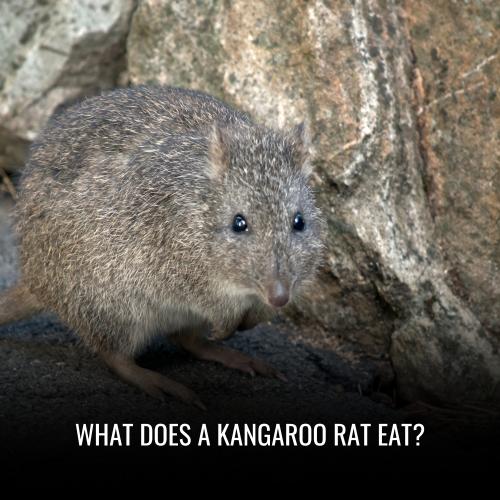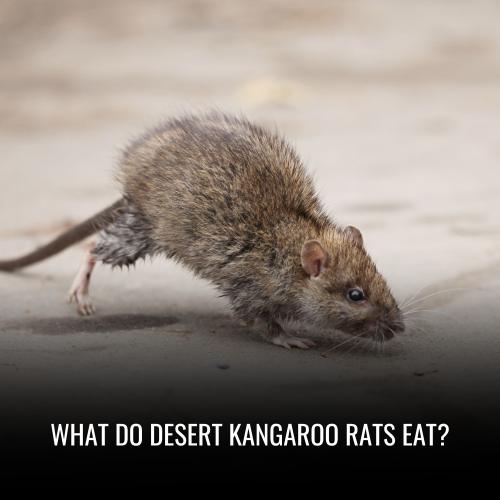What Does A Kangaroo Rat Eat?
Kangaroo rats primarily eat seeds, with their diet mostly consisting of mesquite beans and grass seeds. They also occasionally consume small insects. Overall, their diet is mostly focused on seed consumption.

Overview of kangaroo rats and their diet:
Kangaroo rats have a diverse diet that mainly consists of seeds, particularly mesquite beans and grass seeds. This preference for seeds provides them with a rich source of nutrients and energy.
Additionally, their ability to extract moisture from their food allows them to survive in the arid desert environment where water is scarce. Kangaroo rats have specialized digestive systems that enable them to efficiently break down and extract moisture from the seeds they consume.
This adaptation allows them to thrive in the desert environment by reducing their dependence on external sources of water. They are also able to conserve water by producing highly concentrated urine. These unique traits enable kangaroo rats to thrive in extremely dry and harsh conditions, making them well-suited for desert living.
Feeding Behavior of Kangaroo Rat:
Kangaroo rats are primarily seed eaters, with a diet consisting mainly of mesquite beans and grass seeds. With their efficient digestive systems, they can extract the maximum amount of nutrients from these tough, fibrous foods. However, they are also known to occasionally supplement their diet with small insects.
This unique feeding behavior enables them to thrive in their arid desert habitats, where food sources can be scarce and unpredictable. Despite being small and seemingly delicate, Kangaroo rats have evolved to be highly specialized and efficient feeders, allowing them to survive and even thrive in their challenging environment.
Habits and Lifestyle of Kangaroo Rat:
Desert kangaroo rats are mostly nocturnal, but may come out during the day. They sleep in their burrows during the day and forage at night when the temperature drops. When searching for food, they roam in a radius of up to 100 meters. They spend their active hours modifying their burrows, constantly digging new tunnels, and opening or plugging entrances.
Desert kangaroo rats are solitary animals, socializing only for mating or rearing young. Each burrow is used by a single individual and they are highly territorial, fiercely driving intruders away from their home range.
When encountering an unknown object, they kick sand to determine if it’s alive or a threat. This kicking behavior also helps them escape traps. They also enjoy dust-bathing in the sand to keep their coat clean and get rid of grease. They are mainly seed eaters but occasionally eat small insects.
Diet and Nutrition kangaroo rat:
The diet of the desert kangaroo rat mainly consists of dried plant matter and seeds, such as the leaves of sage and the seeds of the creosote bush. They are herbivores (folivores) and predominantly rely on consuming seeds and plant material from their natural habitat in the desert.
These kangaroo rats rarely eat succulent plants and occasionally consume small insects as well. Their diet is primarily composed of dried plant matter from the previous year, making them well-adapted to surviving in their desert environment.
Amazing Facts About the Kangaroo Rat
Despite their small size, kangaroo rats have incredibly powerful hind legs that allow them to make impressive jumps. There are so many Amazing Facts About the Kangaroo Rat:
- There are 20 known species of kangaroo rat, living in the desert climates of North America.
- Kangaroo rats move in a bipedal fashion, hopping along on their hind legs like a kangaroo.
- They are very good jumpers and can leap up to 9′ (2.7m) to escape predators.
- Kangaroo rats have adapted well to desert life, as they do not sweat and conserve water.
- To stay cool, they stay in their burrows during the day and come out at night.
- They do not need to drink water, getting any moisture they need from the seeds they eat.
- Kangaroo rats have pouches in their cheeks to carry food back to their burrow.
- They also have very good hearing, which helps them avoid predators – they can even hear the beat of an owl’s wings!
FAQs
Kangaroo rats primarily consume seeds and grains as a staple of their diet. They are herbivores and are especially adapted to thrive in arid environments where water sources are limited.
No, kangaroo rats are strictly herbivores. They do not eat insects or other animals. Their diet mainly consists of seeds, leaves, and other plant materials.
Kangaroo rats have efficient metabolisms that allow them to extract sufficient nutrients from their diet. They typically eat seeds and grains once a day, primarily during the night when they are most active.
Kangaroo rats are well adapted to arid conditions and can often obtain sufficient water from the metabolic breakdown of their food. While they can survive without drinking water for long periods, they may still drink if a water source is available.
Kangaroo rats are known to prefer seeds that are rich in nutrients. They often favor the seeds of grasses, mesquite, and other plants found in their native habitats.
Yes, kangaroo rats can thrive on a diet consisting almost entirely of seeds. Their specialized kidneys allow them to efficiently conserve water, making them well-suited for life in arid regions where water is scarce.
Conclusion:
The kangaroo rat’s unique diet consists mainly of seeds and plant matter. This tiny creature has evolved incredible adaptations to survive in the desert, including the ability to extract water from the food it eats.
So, the next time you see a kangaroo rat hopping through the arid lands, remember that it’s feasting on a specialized menu of natural wonders that keep it thriving in its harsh environment.

